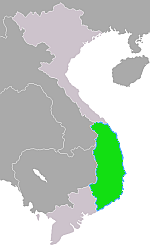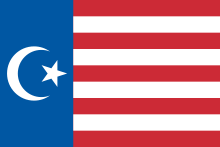This article needs additional citations for
verification. (November 2020) |


The Champa independence movement is a movement for the independence of the Cham people and its attempt to separate from Vietnam. Today's Cham separatism and their notion of nationhood is almost non-existent, according to international researchers. [1]
Background
Champa was a collection of independent Cham polities that extended across the coast of what is today central and southern Vietnam from approximately the 2nd century AD until 1832 when it was annexed by the Vietnamese Empire under Minh Mạng. [2] Once an independent kingdom, Champa had managed to develop its own culture that was strongly influenced from the Indian cultural zone, resulting with its own cultural heritages that separated them from the Sinic Vietnamese in the north, making Champa one of the most important parts of the Indic civilization sphere due to its strong Hindu remnants. [3]
However, with the Vietnamese nation emerged after Chinese occupation, Champa and Đại Việt had engaged in a number of wars. The war series had slowly, but effectively crippled Champa as the country was unable to fend off both threat from the Khmer Empire in the west and the Vietnamese in the north. In order to rescue the country, the Chams adopted Islam as its religion from 15th century, but the Vietnamese conquest at 1471 finally put a de jure end of Champa as an independent state. [4]
Since then, the Chams had rebelled a number of times against Vietnamese domination, the most important rebellions happened to be in the 19th century with Katip Sumat uprising and Ja Thak Wa uprising, making it the first and, so far, the only jihadist war in Vietnamese history. [5] Both had been crushed by the Vietnamese Empire. In 20th century, especially the Vietnam War, the Chams were active as part of Front for the Liberation of Champa, and later, the United Front for the Liberation of Oppressed Races, rebelling as part of their desire for independence. [6] [7] All these rebellions were eventually crushed down by the unified communist government, and the Cham population was significantly reduced.
Arguments about Cham identity
Arguments in favor for independence
Cham advocacy groups argued that, as Champa had been an independent country until being finally annexed to the Vietnamese territory at 1832, the Chams have the rights to regain back what it had lost. Cham advocacy groups have also criticized the Vietnamese government of usurping history and denying the existence of Champa as a state and its systematic atrocities against Chams. [8] [9] [10]
Many Chams believed that the Vietnamese government would never allow any official researches over the Cham history in fear of possible uprising against Vietnamese rule by the Cham population. [11] However, due to the small size of Cham population today, it often meets with strong counter-argument from the Vietnamese side.
Cham independence advocators often cite its war against Vietnamese expansionism as an example how Champa should be independent as it used to be. [12]
Arguments against independence
According to Cham activists, the Vietnamese, regardless of political stances, have been strongly against any kind of independence movement by the Chams, and thus hostile to the Champa independence movement. This has never extended to racial relationship, however, as Vietnamese people, including many Overseas Vietnamese, are totally indifferent on their view with the Chams as a fellow people and unaware of historical discourses, according to Julie Thi Underhill. [13]
Po Dharma, who was a major researcher of Champa's history, while critical to the Vietnamese government's treatment of the Chams, believed that Vietnam should respect the Cham heritage as Champa's history is often intertwined with Vietnamese history, if not to say, part of it. [14]
Among all Vietnamese historical war accords, wars against Champa also take a popular feeling of pride among majority of Vietnamese and the conquest is highly venerated in the country. [15] [16] [17]
Many Vietnamese also believe that if not for the conquest, Champa might have remained an underdeveloped country like Laos and Cambodia, and improvement could be seen under Vietnamese rule rather than Cham rule. [18] Another popular Vietnamese narrative is, although Champa did not exist, but the Vietnamese government since modern days had tried to reconcile and research history of Champa as an entity and its own civilization, culture and customs, thus the Cham nationalist narrative of persecution is untrue. [19]
Other opinions
In the Muslim world, where the Chams seemed to have a close bond due to religious conversion to Islam in 15th century, the persecution of Chams is little-known in the Muslim world. This is due to it being overlooked and due to strong Muslim sympathy to the Vietnamese during its war for independence from France. [20] On the other hand, its Islamic conversion happens to be a huge disadvantage, due to the September 11 attacks which antagonized Muslims across the world may have further alienated Champa independence movement. [20] This lack of awareness might have also contributed to the factor that Vietnam has never been targeted by Islamic extremists despite its maltreatment of Cham people.
In the United States, the Chams were considered to be ally during the Vietnam War, but the Americans' main objective was to help reinforcing Chams and South Vietnam into a common alliance against North Vietnam, which was never achieved due to historical antagonism of two sides. [21] Following the fall of South Vietnam and intensifying persecution, many Chams resettled in the United States and had sought to revive and protect the Cham culture while dealing with a much larger and more populous Vietnamese American community that is not fond of Champa's independence objective either. [22] [13]
The Khmer Rouge was initially antagonistic to the Chams and had committed mass atrocities against Chams, but due to the Cambodian–Vietnamese War, had turned on and tried to seek support from the Chams to fight the Vietnamese invasion. [23]
See also
References
- ^ Phuong, Tran Ky; Lockhart, Bruce (2011-01-01). The Cham of Vietnam: History, Society and Art. NUS Press. p. 40. ISBN 978-9971-69-459-3.
- ^ Parker, Vrndavan Brannon. "Vietnam's Champa Kingdom Marches on". Hinduism Today. Archived from the original on 7 October 2019. Retrieved 21 November 2015.
- ^ "India-Vietnam's Shared Culture: The Cham Civilization | USC Center on Public Diplomacy". www.uscpublicdiplomacy.org.
- ^ "Vietnam-Champa Relations and the Malay-Islam Regional Network in the 17th–19th Centuries | Kyoto Review of Southeast Asia". kyotoreview.org. 11 March 2004.
- ^ Wong Tze-Ken, Danny (August 1, 2013). "The Cham Arrivals in Malaysia: Distant Memories and Rekindled Links". Archipel. 85 (1): 151–165. doi: 10.3406/arch.2013.4389 – via www.persee.fr.
- ^ SCUPIN, Raymond (1995). "Historical, Ethnographic, and Contemporary Political Analyses of the Muslims of Kampuchea and Vietnam". Sojourn: Journal of Social Issues in Southeast Asia. 10 (2): 301–328. doi: 10.1355/SJ10-2G. JSTOR 41056916 – via JSTOR.
- ^ Chickering, William H. (June 9, 2017). "Opinion | A War of Their Own". The New York Times.
- ^ "Tháng 6 năm 2013: kỷ niệm 181 năm Champa vong quốc". www.champaka.info.
- ^ "Việt Nam đã xâm lược và đồng hóa Chămpa như thế nào?". WWW.NGUOICHAM.COM. Retrieved 2020-08-14.
- ^ Filippi, Jean-Michel. "The long tragedy of Cham history". www.phnompenhpost.com. Retrieved 2020-08-14.
- ^ Nakamura, Rie (May 5, 2020). A Journey of Ethnicity: In Search of the Cham of Vietnam. Cambridge Scholars Publishing. ISBN 9781527550346 – via Google Books.
- ^ "ANH HÙNG LỊCH SỬ CHAMPA". kauthara.org.
- ^ a b "You Didn't Kill Us All, You Know — Part Two | Blog | Critical Refugee Studies Collective". criticalrefugeestudies.com. Retrieved 2020-08-14.
- ^ "Lịch sử Champa là một phần của lịch sử Việt nam". Radio Free Asia.
- ^ "Nguyễn Hữu Cảnh: Vị tướng dẹp yên hai quốc gia, mở ra vùng đất Phương Nam - Kỳ 1". www.ntdvn.com.
- ^ nói, Hữu Bình (September 30, 2015). "Cuộc xung đột Việt Chiêm trong tiến trình lịch sử dân tộc".
- ^ "Chiến thắng Trà Bàn của vua Lê Thánh Tông (1471)". danang.gov.vn.
- ^ "Central Vietnam emerges as world's gateway to ASEAN – Ba Thien 2 IP".
- ^ Nakamura, Rie; Sutherland, Claire (March 2019). "'Cracking' the Nationalist Narrative? Representing Cham and Champa in Vietnam's Museums and Heritage Sites". Museum and Society. 17: 52–65. doi: 10.29311/mas.v17i1.2819. S2CID 126594205.
- ^ a b "Oppression of Cham Muslims being overlooked". April 13, 2015.
- ^ "Curiosity of foreigners aids Muslims in Vietnam". The Irish Times.
- ^ "No Longer Invisible: Faridah Abdullah".
- ^ Kiernan, Ben (December 1, 1988). "Orphans of genocide: The Cham muslims of Kampuchea under Pol Pot". Bulletin of Concerned Asian Scholars. 20 (4): 2–33. doi: 10.1080/14672715.1988.10412580.